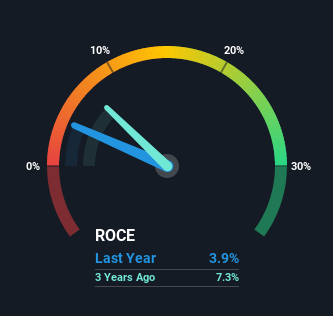Investors Could Be Concerned With American Vanguard's (NYSE:AVD) Returns On Capital
Finding a business that has the potential to grow substantially is not easy, but it is possible if we look at a few key financial metrics. Amongst other things, we'll want to see two things; firstly, a growing return on capital employed (ROCE) and secondly, an expansion in the company's amount of capital employed. Basically this means that a company has profitable initiatives that it can continue to reinvest in, which is a trait of a compounding machine. Having said that, from a first glance at American Vanguard (NYSE:AVD) we aren't jumping out of our chairs at how returns are trending, but let's have a deeper look.
Return On Capital Employed (ROCE): What is it?
For those who don't know, ROCE is a measure of a company's yearly pre-tax profit (its return), relative to the capital employed in the business. The formula for this calculation on American Vanguard is:
Return on Capital Employed = Earnings Before Interest and Tax (EBIT) ÷ (Total Assets - Current Liabilities)
0.039 = US$22m ÷ (US$735m - US$166m) (Based on the trailing twelve months to June 2021).
So, American Vanguard has an ROCE of 3.9%. In absolute terms, that's a low return and it also under-performs the Chemicals industry average of 10%.
View our latest analysis for American Vanguard
Above you can see how the current ROCE for American Vanguard compares to its prior returns on capital, but there's only so much you can tell from the past. If you'd like to see what analysts are forecasting going forward, you should check out our free report for American Vanguard.
What Can We Tell From American Vanguard's ROCE Trend?
When we looked at the ROCE trend at American Vanguard, we didn't gain much confidence. Over the last five years, returns on capital have decreased to 3.9% from 5.6% five years ago. Although, given both revenue and the amount of assets employed in the business have increased, it could suggest the company is investing in growth, and the extra capital has led to a short-term reduction in ROCE. If these investments prove successful, this can bode very well for long term stock performance.
The Bottom Line
In summary, despite lower returns in the short term, we're encouraged to see that American Vanguard is reinvesting for growth and has higher sales as a result. These trends don't appear to have influenced returns though, because the total return from the stock has been mostly flat over the last five years. So we think it'd be worthwhile to look further into this stock given the trends look encouraging.
One more thing, we've spotted 4 warning signs facing American Vanguard that you might find interesting.
While American Vanguard may not currently earn the highest returns, we've compiled a list of companies that currently earn more than 25% return on equity. Check out this free list here.
This article by Simply Wall St is general in nature. We provide commentary based on historical data and analyst forecasts only using an unbiased methodology and our articles are not intended to be financial advice. It does not constitute a recommendation to buy or sell any stock, and does not take account of your objectives, or your financial situation. We aim to bring you long-term focused analysis driven by fundamental data. Note that our analysis may not factor in the latest price-sensitive company announcements or qualitative material. Simply Wall St has no position in any stocks mentioned.
Have feedback on this article? Concerned about the content? Get in touch with us directly. Alternatively, email editorial-team (at) simplywallst.com.

